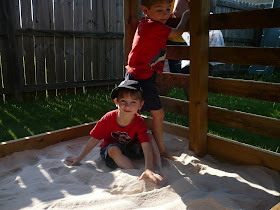One of the reasons autism is so hard on a family is because autism is expensive.
I mean, really expensive.
It doesn't cost anything to have autism, of course; the expense is in the therapy. Even if covered by insurance, co-pays are about $35 a visit for OT - x2 kids, x4 times a month...I get nauseous at this point so I'm not sure what the math comes out to.
The good news is, you can do SO MUCH at home!
photo by Carly Watson
Today let's talk O.T.
Occupational Therapy is a crucial piece of the autism puzzle.
This therapy addresses a persons' need for skill development in motor, cognitive, perceptual, play, and social skills. Many essentials for daily living are strengthened by O.T.
The areas of O.T. that we've focused on are fine and gross motor, sensory and feeding.
Although doing these things at home are not a replacement for the expertise of an occupational therapist, they will complement the therapies you're receiving. Any good therapist will tell you that the therapy must be reinforced at home to be truly beneficial. Most of the items below are things you have in your home anyway or are toys your child would love to receive. Many of these items would make great birthday gifts or Christmas presents. If you are unable to afford therapy for a time, I would say something is better than nothing.
Occupational Therapy is available through your school system and should be written into your IEP. If your child is on the spectrum and in school full time, he should absolutely be receiving this. If you homeschool and cannot afford private therapy, consider doing what we did last year with our "buffet approach." In our IEP, we wrote in that the boys would attend for three days a week, 2 1/2 hours at a time which gave us just enough time to take advantage of services. We had no academic goals for last year at school; we covered that part at home with homeschool. If you homeschool and can afford it, a private therapist is the way to go.
A wonderful resource for finding toys for specific skills is Toys R Us' Differently-Abled Toy Guide. Another great resource is the book, The Out of Sync Child.
Fine Motor
As lego fanatics, we work on fine motor skills every day.
B. Pop-Arty! Funky Pop Beads
Any art work - cutting, gluing, coloring, etc.
Puzzles
Board Games
Lacing Cards
Gross Motor/Sensory
Trampoline
We have a mini trampoline in our living room. They sell indoor trampolines with or without handle bars.
Playdoh
Bean/rice bucket
Couch Cushions
What kid doesn't love to pull all the cushions off the couch and jump from one to the other? Instead of it being a frustration in our house, we consider it therapy. **Note, we also don't have really nice couches...and probably won't for a long time for this reason!
Roughhousing and Wrestling - especially with Daddy
Rolling, flipping, jumping jacks
Pushing and pulling heavy things...like the laundry basket!
Gluing and Stapling Paper
Tickling back
Popping bubble wrap
Really tight squeezes or hugs
Bouncing balls
Use a variety of sizes. Some for bouncing with hands, some for sitting on and bouncing up and down. Those exercise balls getting dusty in your closet are great for this ;).
Bouncing on the bed
Yes, more monkeys jumping on the bed
Jumping off the bed or couch
Musical Instruments
Water play
Bathtub, outside, in a pool, wherever, water play is great sensory input.
Spinning in circles
Sensory balls
Scanimation picture books, like Swing
Playing tag
Petting the dog/cat
Rolling on the floor
Wrapping tight in a blanket
Sitting in a dim, quiet room listening to soft music or reading
We do this almost every day in the form of our Rinnagade Siesta.
Playset: Sand, Slide, Climber, Swings
Me: "hunny, I know you've never really built anything, but can you build a swingset for the boys?"
Awesome Husband: "sure."

There's a reason these things are on every playground. The sand is so good for sensory input that my oldest spent the first week just going out there and laying in it. Climbing and sliding are not just good sensory but gross motor development and swinging is a must for sensory input.
S.O.S. Feeding Therapy
This therapy has helped us a great deal with increasing our food options. For problem feeders and picky eaters, this is a must! Again, the principles can all be reinforced at home and implemented as soon as today. For more ideas, see my series, Growing a Good Eater.

What are your at home O.T. ideas?




That is one lobbying group that I would certainly support. Thank you for your work..
ReplyDeleteTreatment for Autism in India
John, thanks so much for your comment and for reading!
Delete